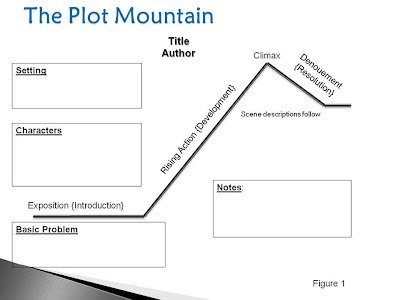Now that you have read through a work once for the pleasure of it and come to understand the unfamiliar words in it you are ready for the real work of analysis. This article will define the terms and describe the process of analyzing the plot of a work of fiction.
The fact is that a story has as much structure as does a persuasive essay or an informational article. It is, of course, called the plot. There are basically 4 parts to a plot:
1. Exposition or Introduction – earliest part of the work. Setting, Characters (at least the protagonist or antagonist), and Basic Problem are introduced. Sometimes this is a prologue before the actual story narrative begins and other times it is accomplished in the first part of the narrative itself.
2. Rising Action or Development – the part of the work in which the story is developed and moves scene-by-scene to its climax.
3. Climax – the moment of decision here the protagonist ‘succeeds’ or ‘fails’
4. Denouement or Resolution – where the decisive action of the climax ‘plays out’ to the ending (Or the hook to a sequel). Sometimes the narrative continues to the ending, sometimes an epilogue is used.
Generally a work goes chronologically through the story. That is, from start to end in order of time. There are two literary devices that interrupt that order:
1. Flashback - where the reader gets a glimpse back to the past in the midst of the story
2. Flash forward – the opposite, where the reader gets a glimpse of the future.
Often the fun of reading is in realizing, in the end, that you’d been handed clues along the way that might have told you what would happen later. Every good mystery story is structured around really cleaver clues and a final plot twist that is really not a twist if ONLY you’d caught all the clues. Each clue, from the title to details in the action is a foreshadowing. So often, after the fact, you can find foreshadowing all over your favorite stories.
As you re-read your story, keep track of it scene by scene. A scene is a segment that all ‘happens together’ or happens all in one place or time. In a novel each chapter might be several scenes, or perhaps just one. If you are analysing a story poem, think of stanzas as possibly each being a scene. In a short story perhaps 3 or 4 paragraphs. The exact break points you use don’t make so much difference; use your own judgment for the boundaries of individual scenes. For each scene make a note of the major points of action, details learned about major characters, and quotable quotes that you find. For each and every notation identify it by line number [or page and paragraph].
Finally, use an organizer, like the plot ‘mountain’ type above. Fill out the 3 exposition boxes first. Then decide on your exposition scene(s) and put their numbers on the first (flat) section of the graph. The climax scene number goes at the apex. The other scenes take their places on the graph where they belong before or after the climax, in order. The Notes box can be used for foreshadowings and any other ‘oddities’ of the plot that you want to remember as you go on.
As you organize the details of plot you are also, as you will see, gathering much of what you will need in later parts of the analysis. Download a blank ‘Plot Mountain’ from the Literary Analysis Materials page.
If you are working alongwith the series go now to Literary Analysis Step 3 - Example- The Lady, or the Tiger?
If you are working alongwith the series go now to Literary Analysis Step 3 - Example- The Lady, or the Tiger?
Jo Karabasz
Download this article as a file HERE
GO on to Step #4 >>>

No comments:
Post a Comment